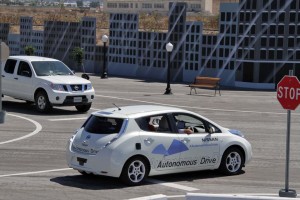Betting on huge demand from motorists in the world’s increasingly crowded mega-cities, Nissan CEO Carlos Ghosn has laid out an aggressive timetable for bringing the maker’s autonomous vehicles to market.
Even before the first of those self-driving cars goes on sale in 2020, said Ghosn, Nissan will launch new technologies, such as automated lane controls and highway traffic management systems that will begin to supplement the driver behind the wheel.
Nissan is aiming to take the lead in the development of autonomous technologies but is likely to face a battle as other automakers enter the field – as well as tech giant Google which will begin launching field tests this year of a new prototype self-driving vehicle it has developed. The race could find a willing public, according to a new study by Navigant Research forecasting annual sales of autonomous vehicles could reach 95 million by 2035.
“By the end of 2016, Nissan will make available the next two technologies under its autonomous drive strategy,” said Mr. Ghosn.
“We are bringing to market a traffic-jam pilot, a technology enabling cars to drive autonomously – and safely – on congested highways,” he explained. “In the same timeframe, we will make fully-automated parking systems available across a wide range of vehicles.”
Last year, Nissan’s global product chief Andy Palmer revealed the maker’s goal of putting its first fully self-driving vehicle into production by 2020. It is already demonstrating that capability with prototype Leaf electric vehicles outfitted with an array of camera, radar, laser and sonar sensors. But it is already equipping some of its products with some of the basic technologies that will be part of a fully autonomous car.
That includes the steer-by-wire system on the new Infiniti Q50 that eliminates the traditional, mechanical link between the steering wheel and the tires. (There is, however, a backup system in case the sedan loses power.)
(Daimler reveals autonomous heavy truck program. Click Here for a closer look.)
The traffic jam and automated parking systems will be followed in 2018 by the introduction of what Ghosn described as “multiple-lane controls,” during a speech to the Foreign Correspondents Club of Japan.
This system, he explained, will allow “cars to autonomously negotiate hazards and change lanes. And before the end of the decade, we will introduce intersection-autonomy, enabling vehicles to negotiate city cross-roads without driver intervention.”
While there are plenty of skeptics who still question the potential for autonomous vehicles, more and more automakers are entering the field, as well as industry suppliers and tech giant Google, which plans to roll out a fleet of 100 prototypes, many of which won’t even have back-up controls, such as a steering wheel or brake.
(For more on Google’s plans, Click Here.)
For his part, Ghosn said there are four key trends that should drive demand for autonomous vehicles:
- The rise of mega-cities where traffic congestion is making it increasingly difficult to drive;
- Rising demand for connected vehicles;
- A “generation gap,” with younger buyers demanding technologies that will ensure their safety while driving;
- A need to “embrace gender diversity,” women also seeking safer, high-tech vehicles.
Whether Nissan will meet Ghosn’s goal of leading the market for self-driving vehicles remains to be seen, but the new Navigant study suggests there’ll be opportunity for all as the technology becomes not just a niche but transforms into the dominant form of automotive transportation. By 2035, Navigant anticipates automakers around the world will sell 94.7 million self-driving vehicles annually. That number is greater than the entire market for automobiles today.
(Retired Ford CEO Mulally resurfaces at Google, could be link between Motown and Silicon Valley. Click Herefor the latest.)
“Combinations of advanced driver assistance features that can enable semi-autonomous driving are now being brought to market for the first time,” says David Alexander, senior research analyst with Navigant Research. “The cost reductions brought about by increasing volumes and technological advances make the installation of the multiple sensors necessary for such capability feasible.”
In fact, the research firm says that the key obstacles to widespread sales of autonomous vehicles are not technological. Instead, they “relate to liability, regulation, and legislation.”
Indeed, Nissan’s Palmer last year warned that the U.S. may not be the first to get autonomous vehicles on the road because of its combative legal system.
(Bounty on hacking a Tesla Model S underscores increasing cyber auto security risks. Click Here for the story.)



Where did that 95 Million forecast come from? from someone’s orifice no doubt. They must have used the same data as Obama and the EPA when they dreamed up a 54.5 mpg CAFE requirement. It’s amazing how the populace can be duped.